The South Australia Pinafore (1981)
| Sir Joseph Porter | Dennis Olsen |
| Captain Corcoran | Roger Howell |
| Ralph Rackstraw | Thomas Edmonds |
| Dick Deadeye | David Brennan |
| Bill Bobstay | Keith Hempton |
| Bob Becket | Maurice Howie |
| Josephine | Judith Henley |
| Little Buttercup | Isabel Veale |
| Hebe | Claire Primrose |
Chorus of State Opera of South Australia
Adelaide Symphony Orchestra
Director: Dennis Olsen
Conductor: Denis Vaughan
This State Opera of South Australia production of H.M.S. Pinafore was Australia's first opera simulcast. It was shown on Sunday, October 11, 1981, and later U.K. television, but it has not been released on home video. Robert Morrison reports:
My recollections of the production, (having seen it only once during the 1981 TV simulcast), was that it was a fairly traditional staging of the opera in the D'Oyly Carte mold (no doubt influenced by Olsen's tenure with the company), and that its maddest moments came during the multiple encores of "Ring the merry bells on board ship" — which concluded with Olsen opening a trap door to reveal a secret compartment in the ship's mast and shutting the door behind him, only to emerge a moment later in a cape and diving flippers and launching himself 'overboard'.
Robert provided a magazine article from the October 1981 issue of 24 Hours (pp. 2–4), which is reproduced below.
G & S: Behind the Simulcast's Busy Scenes
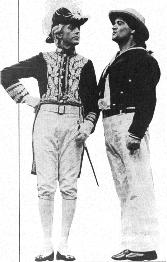 Sir Joseph & Ralph |
Australia's first opera simulcast, Gilbert and Sullivan's HMS Pinafore by the State Opera of South Australia, screens on ABC TV with stereo on ABC FM at 8.30 pm on Sunday, October 11. 24 Hours takes you behind the scenes:
The sensual swish of women's skirts as they daintily swirl on stage can sound like a roaring hurricane: a hand tapping light on a ship's rail rivals the karate chop of Cyclops, while sailors rushing up on deck from the hatch resemble in sound an invasion by the hordes of Atilla the Hun.
Such were the problems to be overcome when the ABC sailed into uncharted waters to mount the first opera simulcast from a live production of HMS Pinafore by the State Opera of SA. As a broadcasting trailblazer the project involved an enormous amount of planning, yet only so much could be done on paper — the reality was to take the production unit into an ad lib situation.
The audience enjoyed a rollicking and critically aclaimed production, aware that a TV special was being made but blissfully unaware of the behind-the-scenes activity and even drama, such as when a hidden microphone was blasted into ear-shattering distortion when a performer accidentally gave it a clout.
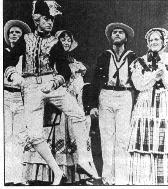 Sir Joseph demonstrates a hornpipe. |
The siting of mikes had been a major hurdle. Sound quality was paramount, but who wanted mikes hanging all over the place casting shadows and taking away the magic of the spectacle? Perfectionists were handling the production and compromise was a dirty word. While hidden mikes unobtrusively gave the optimum in sound, they also created problems — one dress rehearsal was wrecked when a scenery mike reacted to stage dimmer lights. Others picked up the singing beautifully, along with the stage rumble caused by the dancing! But no problem was insurmountable, even with unpredictable audience applause.
While an obvious solution would have been to cut down on the number of mikes used, no compromise in sound quality would be considered and the TV and radio crews 'lived dangerously' to obtain the optimum results. Eventually, 18 mikes were hidden on stage, with a carefully orchestrated schedule to operate or shut-down, depending on the nearby action.
The ABC had recorded television opera before and done opera for stereo FM. But a simulcast is not simply putting the two techniques together: that method, in fact, could prove quite disconcerting, as in a TV production the sound becomes almost subordinate. With a simulcast the sound and image have to come together very closely, so the eye and ear work together.
The eye can be fooled into believing it is following the ear, as was proved by the spontaneous Royal Wedding simulcast, when many people replaced the TV commentary with ABC FM's stereo broadcast. With HMS Pinafore, the theatre production was keyed to the simulcast to avoid any confusion through a lack of harmony between picture and sound.
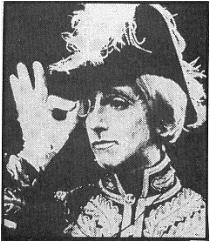 A skeptical Sir Joseph |
Said Roger Parker, the ABC's music producer for the project: "The most obvious conflict between television and stereo is one of dimension, the picture being about 53 cms wide and the stereo spread up to three metres. This can be minimised by a little care. As the Adelaide Symphony Orchestra is never seen, it was laid out using the full width of stereo, and the stage which is seen, was narrowed to about two-thirds the width of the stereo, which brought the voices to the limits of just either side of the television screen — in fact, this was built in for us in the stage production, as most of the main action took place on the centre half of the stage.
"Any entrances and exits were followed by the camera and the stereo naturally moved with it, fooling the eye to follow the ear. In the chorus sections the ear hears nearly full-width stereo and the camera picks out some of the performers, rather like you would if you were sitting in the theatre. As the ear cannot locate the particular sound on camera, there is no confusion. A simulcast of a live show can make you feel you are there, sitting in the front row of the stalls.
"HMS Pinafore by the State Opera had the right ingredients for our simulcast, a landmark in Australian broadcasting and the forerunner of further such combined telecasts-broadcasts. Adelaide's Festival Theatre has good facilities for lighting and camera placement, and a large orchestra pit which by most opera house standards produces a good sound.
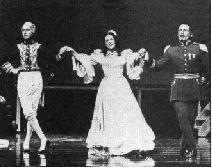 The Bell Trio |
"And, perhaps most importantly, we knew we had the right repertoire to present fo a first opera simulcast. Gilbert and Sullivan has a large following, confirmed by a survey commissioned by the Australia Council last year. The simulcast really comes into its own with opera. Opera is glorious in stereo and makes good colour television. But put the two together and you've really got something. The presentation of opera on television with stereophonic sound ensures that the widest possible audience can enjoy the experience."
Any project of such magnitude is bound to have setbacks, challenges to be overcome. But this particular production was almost scuttled before production began. After all the high flying of planning, gloom descended with a mighty thump when the delivery date of the special stereo sound video recorders essential for the production was delayed until after the Pinafore season. Nor could replacement equipment arrive in time.
While most videotape recorders carry more than one soundtrack, the quality is just not good enough for FM stereo broadcast. As it seemed that the Pinafore Project might finally dip beneath the waves, 'backroom boys' Paul Lawson, radio, and Allan Dent, TV, examined ways of driving a sound recorder with a video recorder, using existing equipment and maintaining the essential high quality of sound.
The result was a piece of synchronisation equipment now known affectionately as 'The Dent Box'. The setback even became an advantage, with The Dent Box facilitating editing, allowing sound and video to be tackled separately. The standard for sound and vision syncing in film is 1/50th of a second, and The Dent Box achieved a negligible phase shift.
Allan Dent, who lives and breathes electronics, and who's been elevated to the status of genius as the show's saviour, was extremely modest about his achievement — "My job was to design and build a control box to synchronise and lock two Control Track signals during subsequent replays. I had a two-week deadline to meet in which I had to design, construct and debug my control box.... the deadline was met with the final adjustments being made just before the preview began".
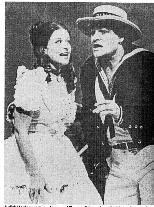 Josephine & Ralph |
The process was nowhere as simple as that sounds. The way to lock any signals on two tape recorders is to have some recoverable reference signal which can then be compared with a master reference in a phase locked servo system. As the videotape recorder being used, an AMPEX VR-2000, uses such a reference (a Contol Track), a split of this reference signal was recorded simultaneously on the fourth track of a four-track AMPEX 440 audio tape recorder being used for the stereo soundtrack. Track four gave maximum separation from the stereo soundtrack on tracks one and two.
After the completion of editing in sound and vision, the program was then transferred onto the stereo VTRs which had now arrived. This removed the worry of going to air live, with the 'Dent Box' syncing the vision and sound. "In spite of its proven reliabilty," said Parker, "it was just using too much equipment in an ad hoc situation — Murphy's Law and all that!"
And incidentally the commercially-manufactured equipment to replace the delayed original order would have cost $23,000. The Dent Box cost just $100!
Pinafore's television producer, Hugh Davison, said that the operetta simulcast had involved a "tremendous team effort by both the ABC and the State Opera." It was the most complex production undertaken by the ABC's Adelaide branch and was one of the first by a newly-formed production unit set up to make more national programs, as well as an increased local content....
HMS Pinafore stars Dennis Olsen, whose role as Sir Joseph Porter is considered a classic. Olsen made his Gilbert and Sullivan debut, to great critical acclaim, in the same role with the Opera Australia in 1969, later spending 12 months touring Britain and Europe with the famous D'Oyly Carte Company. While being lauded for his brillant lunacies as Sir Joseph in the State Opera production, Olsen also won kudos for his witty and fresh production, as HMS Pinafore marked his debut as a director.
The production, under the musical direction of Denis Vaughan, also stars Adelaide tenor Thomas Edmonds, and the talented young Judith Henley. Edmonds and Olsen have recorded two successful albums of Gilbert and Sullivan for the ABC.
To gain the maximum benefit of the simulcast, viewers have merely to switch off the sound on the television set and place the hi-fi speakers as near as possible to an equilateral triangle with the viewer position. The TV set should be at the centre line between the slightly-angled speakers.
HMS Pinafore was produced for television by Hugh Davison, with music production by Roger Parker, technical production by John Newman, sound by Mike Fitzhenry and audio-visual synchronisation by Paul Lawson and Allan Dent.
—Gloria Bruzzone
